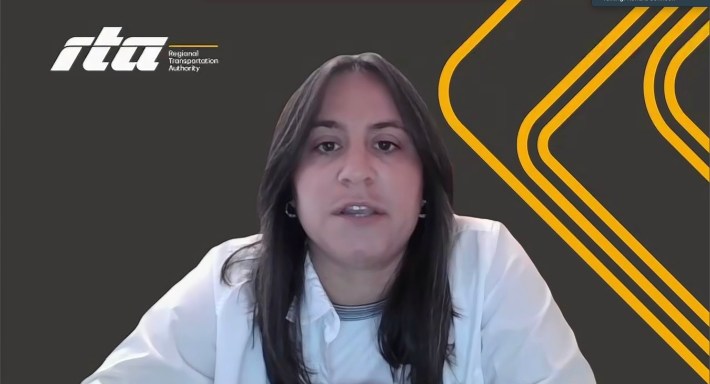
Last Wednesday, July 31, the Regional Transportation Authority, which oversees the CTA, Metra, and Pace, hosted a Transit is the Answer Coalition online meeting. The RTA provided several system updates, including some good news about the current state of Chicagoland transit. But most of the session involved participants sharing their thoughts and feelings about possible ways to improve public transportation in the region.

"Many of you know that we believe that new funding for transit must come with any reforms that are proposed, and really two potential paths forward toward reform for transit have been proposed," said Leanne Redden, executive director of the RTA. "One of them calls for the consolidation of all four agencies basically into one mega-agency, and the other alternative calls for a strengthened regional oversight agency. So the reforms that we are here to discuss today are part of that larger conversation that many of you have been part of, really since the development of our strategic plan, and much of that work centers around developing a stronger RTA."
As Streetsblog Chicago previously noted, CTA, Metra, and Pace ridership have been recovering in 2024, but still have a long way to go to reach pre-pandemic levels. According to the RTA, there have been over one million rides per weekday across the region; crime has gone down as ridership has gone up; and free and reduced fare programs have expanded, including additional fare pilots to meet new travel patterns. The transit systems have been adapting to new commuting patterns, providing additional weekend and midday trips. And the transportation authority says an estimated 90 percent of people who used transit before COVID-19 hit are currently riding buses and trains.

Kendra Johnson, a member of the government affairs team at the RTA, talked about a new service that the RTA has funded. Later this year, a Regional Day Pass will be available on the Ventra app and offer unlimited rides across the region. The fee will range from $6 to $16, depending on where you want to go.
Next, Johnson talked about the upcoming $730 million regional transit fiscal cliff. "It's important to understand that the fiscal cliff is not a one-time event," said Johnson. She explained that if the system does not receive adequate funding in the near term, hitting the fiscal cliff will trigger a death spiral of service cuts, fare increases, and ridership loss that, once initiated, will be nearly impossible to overcome. "It will get worse and harder to solve each year."

State Senator Ram Villivalam (D-8th) held six subject meetings over the summer to discuss the future of Illinois public transportation. These sessions discussed proposed legislation he helped sponsor that would require the four transit agencies to be combined into one agency called the Metropolitan Mobility Authority.
Some transit advocates and the heads of the Illinois and Chicago chambers of commerce voiced support for combining CTA, Metra, and Pace into a single transit agency. However, the RTA says it does not support full consolidation because it doesn't believe that's the most effective way to improve service, and says consolidation doesn't advance the critical need for more transit funding. (Sen. Villivalam's bill calls for an additional $1.5 billion in state funds for transit.)
The Chicago Metropolitan Agency for Planning's Plan of Action for Regional Transit offers two options for transit governance. One consolidates the RTA and the service boards into one organization, while the other gives the RTA more influence and oversight on service, fare policy, and capital project prioritization. Peter Kersten, the RTA's program manager for strategic plan implementation, discussed what the latter could possibly look like.

"The purpose here again is really to get your feedback and input on these proposals," said Kersten. "Hopefully you've reviewed some of the information that was sent in advance of the meeting. In a moment, I'll walk through each concept, and then we'll break out into smaller groups to talk through the details. Our hope is that these specific examples can show how seamless rider experience can be provided and enhanced by a strengthened RTA."
Currently, the CTA, Metra, and Pace individually decide the frequency, schedule, fare levels policy, and capital projects for their systems. With more oversight, the RTA would set a regional standard for all of those things, which could lead to various improvements. For example, the RTA would design services to meet rider needs, expand fare conditions, and achieve broader goals like equity or accessibility. The RTA would not be doing service planning but rather using a regional lens to evaluate how services should be provided.

When Kersten was done, the meeting attendees went through each proposal. Those on the call went into break-out groups to discuss what they thought the best option for the future would be. Once there, a moderator asked a series of questions, such as what they thought the expected level of service across the region was, based on their own experiences.
One attendee was a Lincoln Square resident who said he takes the Lawrence Bus to Uptownforhis job. He say he would like the headways for that bus to be every five minutes, or at least under ten minutes, during peak service hours. Another attendee primarily does an inter-system transfer between Metra and Pace, which can create up to half an hour of transfer times because of the schedules. Obviously, he would have liked the transfer times not to take that long.
After the breakout groups were down, everyone returned to the main group to do more networking and ask questions. Instead of planning to do a full report, the RTA took notes, compiled what they heard, and will do a recap blog post. For anyone who wasn't able to sit in on the Zoom, they should publish that writeup soon.

Did you appreciate this post? Please consider making a tax-deductible donation, to help keep Streetsblog Chicago's sustainable transportation news and advocacy articles paywall-free.





